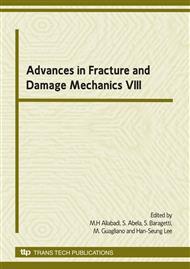p.1
p.5
p.9
p.13
p.17
p.21
p.25
Stresses Developed within Thermally Grown Oxides on a Coated Superalloy Substrate
Abstract:
Residual macro-stresses have to be evaluated using trial samples that comprise a CMSX4 superalloy coated with either a RT22 or a CN91 bond-coat. The samples were exposed in air to a matrix of temperatures, in the range 850°C to 1050°C, and times extending upto 4000hrs to produce thermally grown oxide. This oxide is essentially Al2O3 which allows stresses to be measured by photoluminescence spectroscopy. In addition, Raman spectroscopy and X-ray diffraction have been used to characterise the oxides formed. The results are discussed with respect to confidence in the measurements, changes in stress with temperature and exposure time and the potential for photoluminescence spectroscopy to be used to measure stresses for service components.
Info:
Periodical:
Pages:
5-8
Citation:
Online since:
October 2009
Authors:
Price:
Сopyright:
© 2010 Trans Tech Publications Ltd. All Rights Reserved
Share:
Citation:


